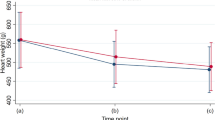Abstract
Purpose Assessment of body size at autopsy is important for interpreting organ weight measurements and in some cases body identification. The reliability of post-mortem body size measurements, the causes for perturbations in these measurements from their corresponding pre-mortem values, and the impact of such perturbations on heart weight interpretation have not been fully explored. Methods Autopsy body length and weight measurements and pre-mortem height and body weight measurements were compared in 132 autopsies. Clinical records were evaluated for peripheral edema and serum albumin levels. Causes of death, body cavity fluid collections, and heart weights were obtained from the autopsy reports. A subset of patients underwent quantitative post-mortem computed tomography assessment of anasarca. Results At autopsy, body weight differed from the pre-mortem value by 11 ± 1 %, compared with −0.2 ± 0.3 % for body length (P < 0.0001). The percent change in body weight at autopsy correlated with the presence of peripheral edema (14 ± 2 % vs. 7 ± 2 %, P = 0.01), serum albumin < 3.0 g/dL (16 ± 2 % vs. 7 ± 2 %, P = 0.001), and the degree of anasarca (P = 0.01). In 4 % of autopsies, heart weights were abnormal based on the pre-mortem body weight, but would be classified as normal based on the elevated post-mortem body weight. Conclusions At autopsy, body weight is a less reliable parameter than body length in correlating with the corresponding pre-mortem measurement. Autopsy body weights are elevated in part due to peripheral edema/anasarca. Alterations in body weight at autopsy can confound the interpretation of organ weight measurements.




Similar content being viewed by others
References
Zeek PM. Heart weight I: the weight of the normal human heart. Arch Pathol. 1942;34:820–32.
Kitzman DW, Scholz DG, Hagen PT, Ilstrup DM, Edwards WD. Age-related changes in normal human hearts during the first 10 decades of life. Part II (Maturity): a quantitative anatomic study of 765 specimens from subjects 20 to 99 years old. Mayo Clin Proc. 1988;63:137–46.
Dadgar SK, Tyagi SP, Singh RP, Hameed S. Factors influencing the normal heart weight—a study of 140 hearts. Jpn Circ J. 1979;43:77–82.
de la Grandmaison GL, Clairand I, Durigon M. Organ weight in 684 adult autopsies: new tables for a Caucasoid population. Forensic Sci Int. 2001;119:149–54.
Gaitskell K, Perera R, Soilleux EJ. Derivation of new reference tables for human heart weights in light of increasing body mass index. J Clin Pathol. 2010;64:358–62.
Garby L, Lammert G, Kock KF, Thobocarlsen B. Weights of brain, heart, liver, kidneys, and spleen in healthy and apparently healthy adult Danish subjects. Am J Hum Biol. 1993;5:291–6.
Hanzlick R, Rydzewski D. Heart weights of white men 20 to 39 years of age: an analysis of 218 autopsy cases. Am J Forensic Med Pathol. 1990;11:202–4.
Hayes JA, Lovell HG. Heart weight of Jamaicans: autopsy study of normal cases and cases of hypertension and chronic lung disease. Circulation. 1966;33:450–4.
Molina DK, DiMaio VJ. Normal organ weights in men: part I-the heart. Am J Forensic Med Pathol. 2012;33:362–7.
Basso C, Burke M, Fornes P, Gallagher PJ, de Gouveia RH, Sheppard M, et al. Guidelines for autopsy investigation of sudden cardiac death. Virchows Arch. 2008;452:11–8.
Singh S, Petrovic D, Jamnik E, Aran S, Pourjabbar S, Kave ML, et al. Effect of localizer radiograph on radiation dose associated with automatic exposure control: human cadaver and patient study. J Comput Assist Tomogr. 2014;38:293–8.
Lo Gullo R, Mishra S, Lira DA, Padole A, Otrakji A, Khawaja RD, et al. Quantification of interstitial fluid on whole body CT: comparison with whole body autopsy. Forensic Sci Med Pathol. 2015;11:488–96.
Lee V, Byard RW. Variation in methods of cardiac dissection—a potential confounder in measuring cardiac weight at autopsy. J Forensic Sci. 2013;58:811–2.
Author information
Authors and Affiliations
Corresponding author
Ethics declarations
Ethical approval
All procedures performed in studies involving human participants were in accordance with the ethical standards of the institutional and/or national research committee and with the 1964 Helsinki declaration and its later amendments or comparable ethical standards. For this type of study formal consent is not required.
Rights and permissions
About this article
Cite this article
McCormack, C.A., Lo Gullo, R., Kalra, M.K. et al. Reliability of body size measurements obtained at autopsy: impact on the pathologic assessment of the heart. Forensic Sci Med Pathol 12, 139–145 (2016). https://doi.org/10.1007/s12024-016-9773-1
Accepted:
Published:
Issue Date:
DOI: https://doi.org/10.1007/s12024-016-9773-1




